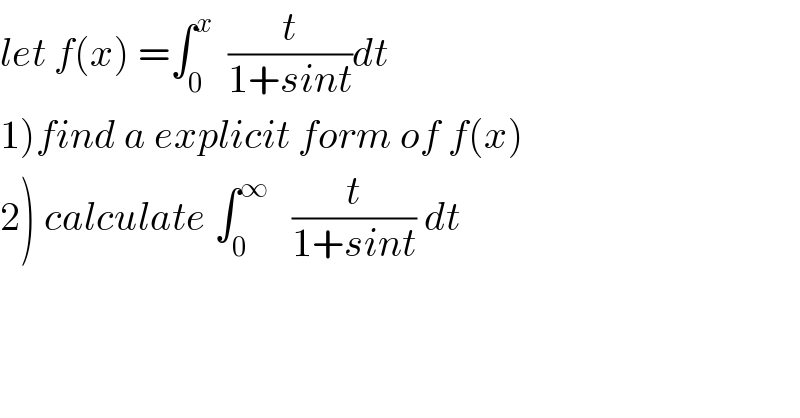Question Number 43337 by math khazana by abdo last updated on 09/Sep/18

Commented by maxmathsup by imad last updated on 11/Sep/18
![1) changement tan((t/2))=u give f(x)= ∫_0 ^(tan((x/2))) ((2 arctanu)/(1+ ((2u)/(1+u^2 )))) ((2du)/(1+u^2 )) = ∫_0 ^(tan((x/2))) ((4 arctanu)/(1+u^2 +2u))du =4∫_0 ^(tan((x/2))) (( arctanu)/((u+1)^2 )) du by parts we get f(x) =4{ [−(1/(1+u)) arctanu]_0 ^(tan((x/2))) +∫_0 ^(tan((x/2))) (du/((u+1)(1+u^2 ))} =−4 (x/(2(1+tan((x/2))))) +4 ∫_0 ^(tan((x/2))) (du/((u+1)(u^2 +1))) but ∫_0 ^(tan((x/2))) (du/((u+1)(u^2 +1))) =(1/2) ∫_0 ^(tan((x/2))) { (1/(u+1)) −((u−1)/(u^2 +1))}du =(1/2)[ln∣u+1∣]_0 ^(tan((x/2))) −(1/4) [ln(u^2 +1)]_0 ^(tan((x/2))) +(1/2) [ arctanu]_0 ^(tan((x/2))) =(1/2)ln∣1+tan((x/2))∣ −(1/4)ln∣1+tan^2 ((x/2))∣ +(x/4) ⇒ f(x) =((−2x)/(1+tan((x/2)))) +(1/2)ln∣1+tan((x/2))∣ −(1/4)ln∣1+tan^2 ((x/2))∣ +(x/4) .](https://www.tinkutara.com/question/Q43511.png)
Commented by maxmathsup by imad last updated on 11/Sep/18

Commented by maxmathsup by imad last updated on 11/Sep/18

